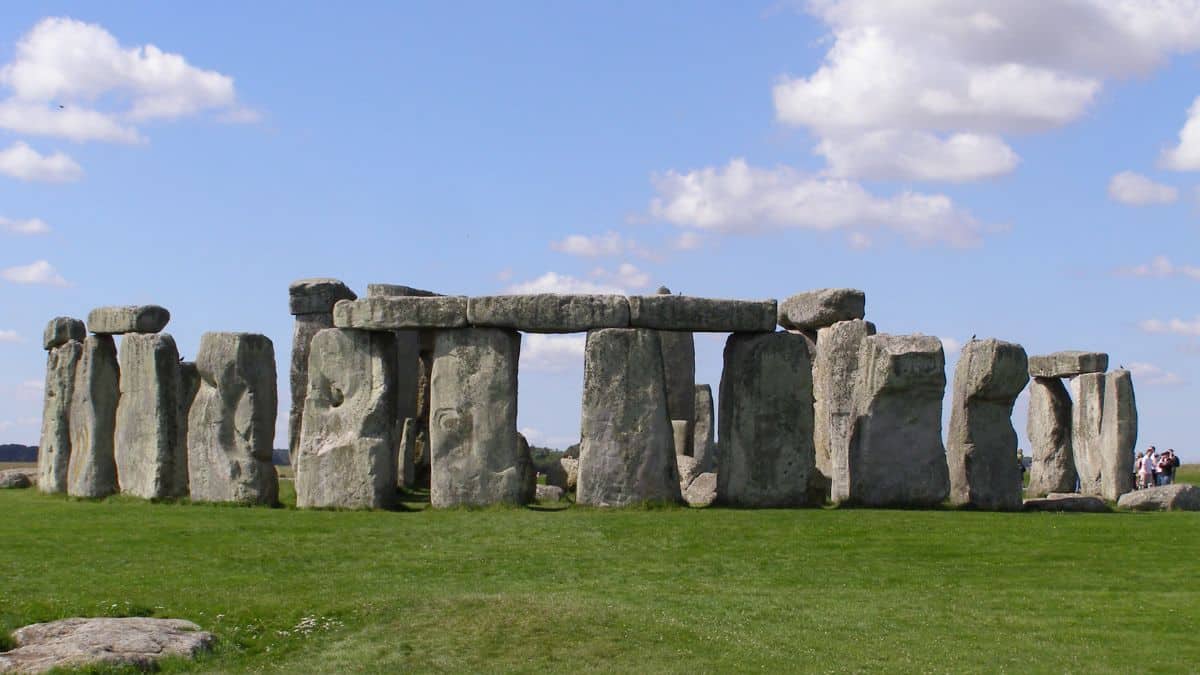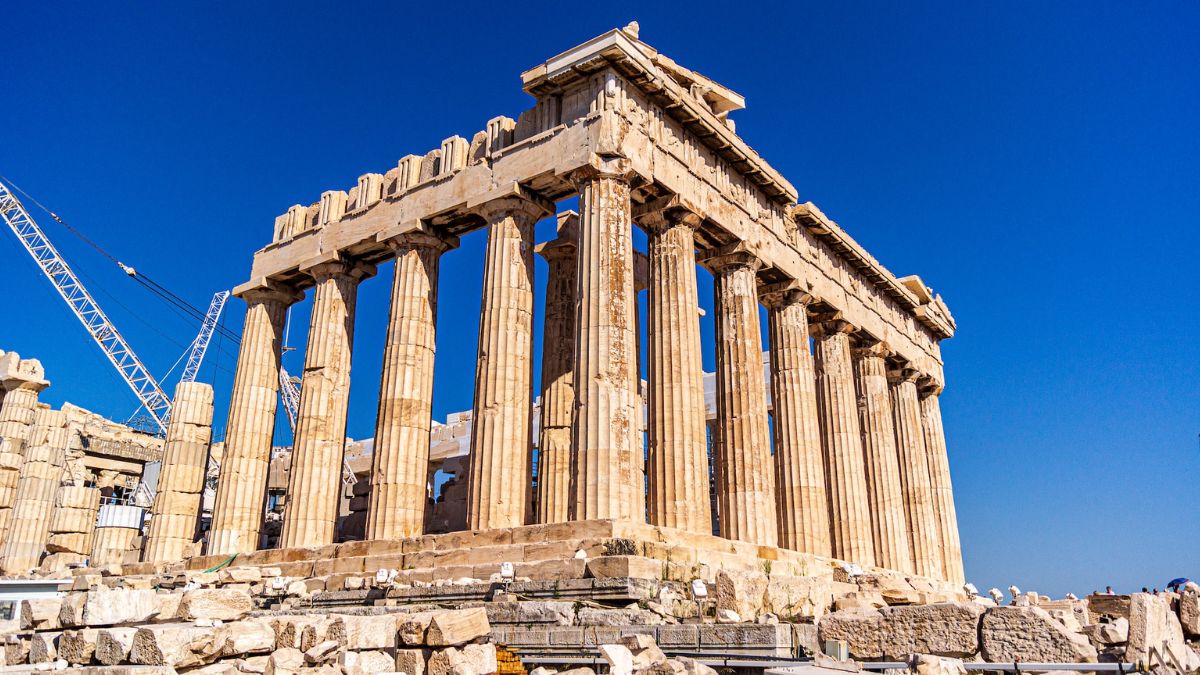Step into a world where time dissolves, and history comes alive. In this captivating journey, we delve into the past and unravel the secrets of the 10 oldest monuments in the world. The oldest monuments in the world are not mere structures of stone and mortar; they are gateways to the past, narrators of ancient civilizations, and keepers of cultural heritage.
Let us cherish and preserve these timeless treasures, allowing them to inspire generations to come. These architectural marvels, standing the test of time, continue to awe and inspire. From the mystical pyramids of Egypt to the exquisite craftsmanship of India’s treasures, let’s embark on a virtual exploration of these ancient wonders.
10 Oldest Monuments In the World
The Great Pyramid of Giza, Egypt

Constructed around 4,500 years ago, the Great Pyramid of Giza stands as a remarkable feat of human ingenuity and ambition. It was originally built as a tomb for Pharaoh Khufu, who ruled Egypt during the 26th century BC. The pyramid was meticulously designed and constructed using massive limestone blocks, some weighing several tons, which were quarried and transported to the site with astonishing precision.
The Great Pyramid is an iconic symbol of ancient Egypt and has captured the imaginations of people from around the world for centuries. Its sheer size is staggering: it originally stood at a height of around 146 meters (481 feet) and was the tallest man-made structure in the world for over 3,800 years until the completion of the Lincoln Cathedral in England in the 14th century. The pyramid covers an area of over 13 acres and is estimated to have been constructed using around 2.3 million stone blocks.
Stonehenge, United Kingdom

Stonehenge is a world-famous prehistoric monument located in Wiltshire, England, United Kingdom. It is situated about 8 miles (13 kilometers) north of Salisbury. Stonehenge is one of the most iconic and mysterious archaeological sites in the world and has been designated as a UNESCO World Heritage Site.
The monument itself consists of a circular arrangement of large standing stones, known as megaliths, set within earthworks. The stones vary in size, with the largest standing stones reaching up to 30 feet (9 meters) in height and weighing around 25 tons. Originally, there were around 30 upright stones, known as sarsens, capped with lintels forming a circular outer ring. Inside the outer ring, there is a horseshoe-shaped arrangement of five trilithons (two vertical stones with a horizontal stone across the top).
Stonehenge is estimated to have been constructed in several phases, with the earliest phase dating back to around 3100 BCE and the last major phase completed around 1600 BCE. The purpose and precise methods of construction of Stonehenge remain subject to speculation and ongoing research. The monument’s alignment with the solstices and other celestial events suggests that it had some significance in relation to the astronomical calendar.
The Pyramids of Teotihuacan, Mexico

At the heart of Teotihuacan are its iconic pyramids, which dominate the landscape and stand as a testament to the advanced engineering and architectural skills of the civilization that built them. The most famous and largest pyramid is the Pyramid of the Sun, or “Pirámide del Sol” in Spanish. Rising to a height of over 200 feet, it is one of the largest pyramids in the world. Its massive stone structure and imposing presence evoke a sense of grandeur and power.
Another notable pyramid is the Pyramid of the Moon, or “Pirámide de la Luna.” Located at the northern end of the Avenue of the Dead, it is slightly smaller than the Pyramid of the Sun but still an impressive sight to behold. It served as a ceremonial and ritualistic center, and its elevated position offers breathtaking views of the surrounding ancient city.
The pyramids of Teotihuacan were not only architectural marvels but also held significant cultural and religious importance. They were part of a larger complex that included residential areas, temples, palaces, and other structures. The city itself was meticulously planned, with wide avenues, intricate murals, and a complex social hierarchy.
Although the origins of Teotihuacan remain somewhat mysterious, it is believed to have been inhabited by a diverse population from various Mesoamerican cultures. At its peak between the 1st and 7th centuries CE, Teotihuacan was one of the largest cities in the world, with an estimated population of over 100,000 people. Its influence extended far beyond its borders, as trade routes connected it to other major cities in the region.
The Megalithic Temples of Malta

The Megalithic Temples of Malta are an extraordinary archaeological wonder that offers a glimpse into the ancient civilization that once thrived on the islands. These temples are considered some of the oldest freestanding stone structures in the world, predating famous landmarks like Stonehenge and the Egyptian pyramids.
Built between 3600 BC and 2500 BC, the Megalithic Temples are located on the islands of Malta and Gozo. They are an impressive testament to the architectural and engineering skills of the prehistoric people who constructed them. The temples were constructed using huge limestone blocks, some weighing several tons, which were quarried and transported to the temple sites.
There are several Megalithic Temples in Malta, each with its unique characteristics and architectural style. The most notable ones include Ġgantija, Ħaġar Qim, Mnajdra, and Tarxien Temples. These temples were not only places of worship but also served as important ceremonial and social gathering sites for the ancient inhabitants.
The Great Wall of China

The construction of the Great Wall involved the labor of millions of workers, including soldiers, peasants, and prisoners. It is estimated that hundreds of thousands of people lost their lives during the construction process, and their bodies were often buried within the wall itself. The wall was built using various materials such as stone, brick, and wood, depending on the availability of resources in different regions.
It is a massive structure that spans approximately 13,000 miles (21,196 kilometers), making it the longest wall in the world. The wall was built over several centuries, beginning in the 3rd century BC and continuing into the 17th century AD. Its main purpose was to protect China from invasions by nomadic tribes and to regulate trade along the Silk Road.
Chichen Itza, Mexico

Chichen Itza is a remarkable archaeological site located in the Yucatan Peninsula of Mexico. It is one of the most iconic and well-preserved Mayan ruins in the world, attracting thousands of visitors each year. The site was once a major city of the Mayan civilization and flourished between the 9th and 13th centuries AD.
One of the most famous structures at Chichen Itza is the towering El Castillo, also known as the Temple of Kukulcan. This magnificent pyramid stands at the heart of the site and serves as a testament to the advanced engineering and astronomical knowledge of the Mayans. El Castillo is known for its impressive staircase, which aligns with the equinoxes and creates a shadow that resembles a serpent slithering down the pyramid.
Another prominent feature of Chichen Itza is the Great Ball Court, the largest and best-preserved ball court in Mesoamerica. This massive playing field measures about 545 feet (166 meters) long and 225 feet (68 meters) wide. The Mayans used this court to play the Mesoamerican ballgame, a ritualistic sport with deep cultural and religious significance.
Chichen Itza is also home to the Temple of the Warriors, a grand complex adorned with numerous columns and statues. The temple showcases intricate carvings and depicts scenes from Mayan mythology, including warriors, gods, and feathered serpents. The site is a testament to the rich artistic and architectural legacy of the Mayan civilization.
The Mausoleum of Theodoric, Italy

Built in the early 6th century, the Mausoleum of Theodoric is an exceptional example of Ostrogothic architecture. It is an octagonal structure with a striking exterior adorned with geometric patterns and intricate stonework. The mausoleum’s design reflects a fusion of Roman, Byzantine, and Gothic influences, showcasing the cultural richness and artistic sophistication of the time.
The mausoleum is constructed entirely of Istrian stone, which gives it a distinctive appearance and ensures its durability. It stands as a massive monument, with its exterior walls measuring around 10 meters in height. The circular dome that crowns the structure adds to its majestic presence. This monumental tomb was intended to serve as the final resting place of Theodoric, and its construction reflects the grandiosity and reverence with which he was regarded.
Upon entering the Mausoleum of Theodoric, visitors are greeted by a dimly lit interior space. The main chamber is circular and features a central octagonal base, which is believed to have held Theodoric’s sarcophagus. The walls are adorned with beautiful niches and marble slabs, some of which still bear fragments of ancient frescoes and decorations. The overall atmosphere inside the mausoleum is solemn and mysterious, transporting visitors back in time to an era marked by the convergence of different cultures and traditions.
Ellora Caves, India

The Ellora Caves consist of 34 monasteries and temples that were excavated between the 6th and 10th centuries AD. The caves are divided into three main groups: the Buddhist Caves, the Hindu Caves, and the Jain Caves. Each group represents a different religious tradition and displays unique architectural features and artistic styles.
The Buddhist Caves, numbering 1 to 12, are the oldest among the Ellora Caves. They primarily feature viharas (monastic halls) and chaityas (prayer halls) adorned with intricately carved sculptures and reliefs depicting various scenes from the life of Buddha. These caves exemplify the early phase of Buddhist rock-cut architecture in India and provide valuable insights into the religious and cultural practices of that era.
The Hindu Caves, numbered 13 to 29, are the largest and most elaborate group at Ellora. They showcase remarkable craftsmanship and artistic skills. The most famous cave in this group is the Kailash Temple, also known as Cave 16. It is an architectural marvel, dedicated to Lord Shiva, and is the largest monolithic structure in the world. The Kailash Temple is a masterpiece of rock-cut architecture, with intricate carvings, sculptures, and a towering central shrine. The grandeur and scale of this temple leave visitors in awe of the human capability for artistic expression.
The Jain Caves, numbered 30 to 34, represent the final phase of cave excavation at Ellora. These caves are known for their simplicity and elegance. The Jain caves predominantly feature images and sculptures of Tirthankaras (spiritual leaders) and other Jain deities. The most notable cave in this group is Cave 32, also known as Indra Sabha, which contains a beautifully carved shrine dedicated to Lord Indra.
The Acropolis of Athens, Greece

Journeying to Greece, we stand in awe before the majestic Acropolis. It stands as the epitome of ancient Greek architecture and culture. One of the most famous structures on the Acropolis is the Parthenon. Built in the 5th century BCE, the Parthenon is a magnificent temple dedicated to the goddess Athena, the patron deity of Athens. It is an outstanding example of classical Greek architecture and is renowned for its harmonious proportions and intricate decorative details. The Parthenon was constructed using white marble and adorned with elaborate sculptures, many of which depicted mythological scenes.
In addition to the Parthenon, the Acropolis is also home to other notable buildings, such as the Erechtheion and the Propylaea. The Erechtheion is a temple dedicated to both Athena and Poseidon, and it features the famous Caryatids, sculpted female figures serving as columns. The Propylaea, on the other hand, served as the monumental entrance to the Acropolis and showcased the grandeur of Athenian architecture.
The Callanish Stones, Scotland

The Callanish Stones, also known as the Callanish Standing Stones or Tursachan Chalanais in Scottish Gaelic, are an impressive and mysterious ancient monument located on the Isle of Lewis in the Outer Hebrides of Scotland. This megalithic complex is composed of a circular arrangement of standing stones, with a central stone circle and four avenues radiating outwards. The stones date back to the late Neolithic era, around 3000 BCE, making them over 5,000 years old.
The purpose and significance of the Callanish Stones remain a subject of speculation and debate among archaeologists and historians. It is believed that they were used for ceremonial and religious purposes by the people who built them. Some theories suggest that the stones were aligned with astronomical events, such as the summer solstice, and served as a sort of calendar or observatory. Others propose that they were associated with rituals and ceremonies related to the cycles of life, death, and rebirth.
Also Read: 10 Famous Prophecies Throughout History



